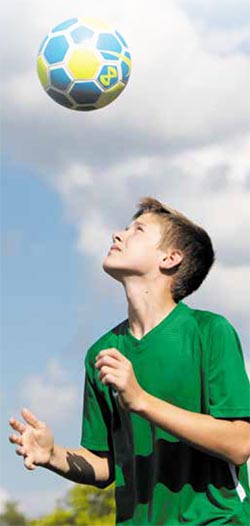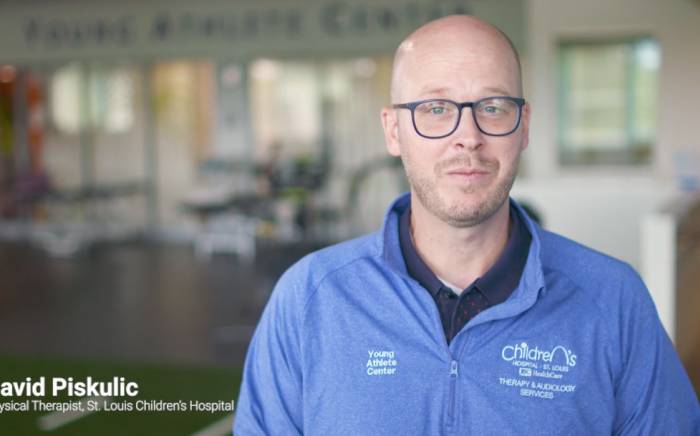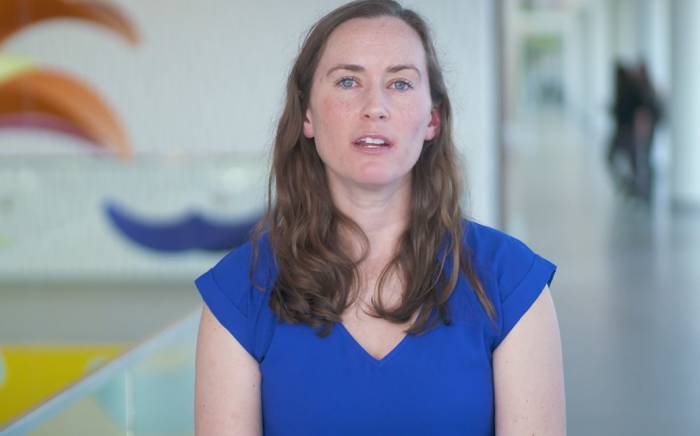 A serious knee injury did more than take soccer from Luke Giesing—it also robbed him of part of his identity. Surgery and rehabilitation at St. Louis Children’s Hospital helped him heal in body and spirit.
A serious knee injury did more than take soccer from Luke Giesing—it also robbed him of part of his identity. Surgery and rehabilitation at St. Louis Children’s Hospital helped him heal in body and spirit.
Luke is an outgoing, sports-loving 14-year-old who is in the eighth grade. He developed a love of soccer by association. His father, Mark, is a high school soccer coach, and Luke and his four siblings grew up around the sport. One evening in January 2018, Luke, then 13, answered a last-minute call from a friend to join an indoor recreational league match. Within the first minute of play, Luke had the ball when an opponent’s tackle caught the back of his ankle and brought him down.
“It was uncharacteristic of Luke to stay on the ground instead of bouncing back up,” says Mark, who saw the tackle from the stands. “I thought it might be a bad sprain. I went to the bench at halftime, and Luke was in serious pain. We needed to see a medical provider.”
The next morning, at a local orthopedic practice, Luke received a diagnosis—a torn anterior cruciate ligament (ACL) in his right knee. ACL tears are increasingly common in young athletes, especially girls, as more and more children participate in sports and many play one sport year-round without giving muscles and ligaments a chance to recover. Physicians were reluctant to perform ACL reconstruction surgery because the growth plates in Luke’s knee were still open. They recommended he wear a knee brace for a few years until he stopped growing and it was safe to operate. Playing soccer was off the table.
Life Reconstructed
During late winter and early spring of 2018, Mark watched with concern as his son’s mood and habits changed.
“Before the injury, Luke would run out the door as soon as he got home from school and play sports,” Mark says. “He went from that to sitting in front of a screen playing video games. He clearly wasn’t happy.”
Mark reached out to families in the St. Louis soccer community for advice about seeking a second opinion. A family whose teenage son had undergone successful ACL repair recommended Jeffrey Nepple, MD, MS, a Washington University pediatric and adolescent orthopedic surgeon at St. Louis Children’s Hospital and director of the Washington University and St. Louis Children’s Hospital Young Athlete Center (YAC). Mark and Luke met Dr. Nepple in April. Dr. Nepple explained to them the ins and outs of surgically reconstructing the ACL in a child who’s still growing.
“When a child has a lot of growth remaining, as Luke did, the risk of injury to the growth plates during standard ACL reconstruction is significant,” he says. “We use newer techniques to create tunnels through the bone and away from the growth plates. That allows us to restore the ACL without harming the growth plates. Typically, we use hamstring tendons from the patient’s leg to create a new ligament.”
After a family discussion, Luke elected to have surgery. During the operation in May 2018, Dr. Nepple reconstructed Luke’s ACL and repaired a torn meniscus in the same knee, which likely occurred at the same time as the ACL tear.
Self Recovery
Luke visited the YAC for twice-weekly rehabilitation therapy sessions through the summer.
“As a soccer coach, I’ve seen a lot of rehab setups, and the YAC’s was the best,” Mark says. “The therapists were compassionate and in constant communication with Dr. Nepple and his staff.”
One year after his surgery, Luke played in his first soccer match since the injury. A few minutes in, contact with an opponent sent Luke crashing to the turf—but he got right up and continued playing. Luke finished the spring season and returned to his starting role with the team this fall. Luke is happy again, and dreaming of playing in high school and beyond. He’s also helping other athletes by participating in a national study of treatments for pediatric ACL tears through St. Louis Children’s Hospital.
“Luke’s story illustrates that, when growth plates are involved, it’s important to receive care from a team that deals with these issues routinely,” Dr. Nepple says. “At St. Louis Children’s Hospital, that’s what we do.”










